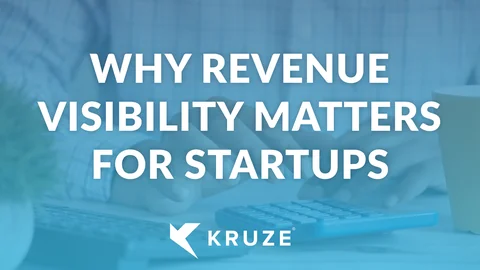
We always encourage revenue visibility to startup founders and it matters for a couple of big reasons, both inside and outside of the company.
Revenue Visibility Outside the Startup
We often tell founders that your company’s venture capitalists are their most important customers. People don’t think about it that way. They think of their VCs as their investors and, in turn, they then think they have a lot of power over them. In actuality, the investors really hold all the cards. They are always going to be there if you stumble and they get to make the decision on whether they’re going to fund you or not.
Therefore, having clear revenue visibility acts as an important relationship tool. Being transparent with them is huge and positively impacts:
- Their faith in your business
- Your credibility
- Their willingness to introduce you to their friends when you go out to raise another round
One common revenue metric is annual recurring revenue (ARR), which is frequently used by SaaS companies that have subscription-based products to measure the annual, predictable, and recurring revenue that they earn. ARR helps VCs and others to understand the scale and momentum of a subscription business. Revenue differs from bookings, which are all the contractual payments you’re scheduled to receive, usually over the next year.
Venture Capital Recommendations
If your VCs have a positive opinion of you, it greatly improves your chances of your VCs referring you to their friends/colleagues. We call it the speed dial. They know their friends. They know who likes to invest in the kind of company that you’re running, and they will make those recommendations if they believe you are:
- Doing well
- Running a good company
- Won’t embarrass them
Revenue visibility helps to establish these impressions with your VCs.
When you have revenue visibility you can confidently tell the board “next quarter we’re going to do $2 million, $10 million, etc.,” for example. For the year you may be able to say “we’re going to do $10 million of revenue or $20 million of revenue” – based on your projections. When you keep hitting those projections and letting your VCs see your progress, you build a lot of credibility, and the whole investor ecosystem opens up for you.
How Revenue Visibility Impacts the Startup Internally
Internally, revenue visibility is really important for staffing and expense management. Ultimately, this translates to your burn rate.
Initially, your startup’s revenue could potentially be bouncing around like crazy (this is commonly happening right now in mid-2023 as times are a little tougher). When startups don’t have great predictability in their revenue, it becomes difficult to actually staff your company correctly.
Sales and marketing are a good example. Ideally, your investment in sales and marketing yields a positive result: Put a dollar in, get three dollars back. Well, if you don’t have revenue visibility, and are unsure of what’s actually happening, there’s a very good chance that if you put a dollar in, you get 50 cents back, or you may get four dollars back. Revenue visibility is very important for making strategic decisions.
In this situation, if you’re performing at a substandard level, you need to dial things back and not just reduce your expenses, like marketing and sales. Instead you should probably reduce some of your overhead costs like:
- Recurring costs like redundant or unused software subscriptions
- General and administrative (G&A) expenses
- Salaries and wages
It all comes down to knowing where you are financially, and that is really, really important.
100% Visibility Can Be Hard At Startups
If you’re a startup, you know that every sale is hard, and getting traction is very difficult. So developing a complete picture of your finances can be a little bit of a fantasy. No one really knows exactly where they are except for maybe huge megacompanies like Google, Apple and Facebook that have a lot of revenue predictability.
Our message is, don’t beat yourself up too much if you’re a founder running a company and you don’t have a precise analysis of your financial position. That’s common in the startup ecosystem. What you’re trying to do is:
- Gain a general idea
- Subsequently rightsize your expenses
- Get a better handle on how much revenue you’re going to bring in
Knowing your revenue will then hopefully translate to a better burn rate and extending your total cash runway (how many months of cash you have).
Revenue Visibility Affects Venture Capital Relationships
Your burn rate and cash flow then funnels back into your relationship with your VCs. If you have visibility and you have a lot of revenue (lot of months left in your runway, for example), you can tell them you don’t need to raise money right now. They don’t have to worry about you. Nothing freaks VCs out more than when you start missing your revenue numbers and your burn doubles, or even triples. You could go from thinking you had 12 months of cash, but suddenly you only have three! That is the nightmare scenario and it’s why revenue visibility really matters.
If you have any other questions on revenue visibility, valuations, startup investing, startup accounting or taxes, please contact us.
You can also follow our YouTube channel and our blog for information about accounting, finance, HR, and taxes for startups!








